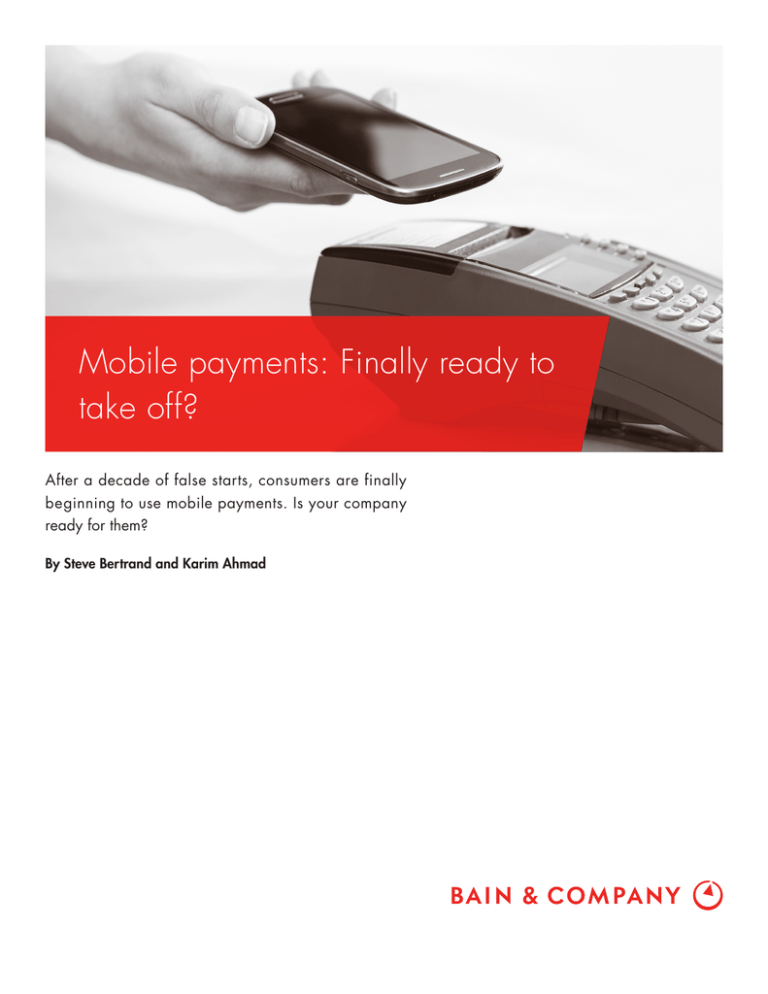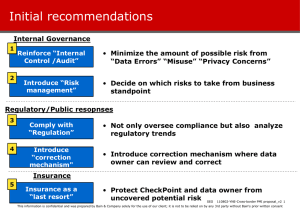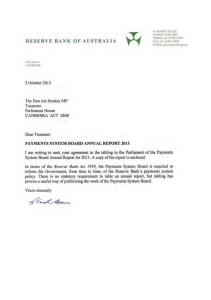
Mobile payments: Finally ready to
take off?
After a decade of false starts, consumers are finally
beginning to use mobile payments. Is your company
ready for them?
By Steve Bertrand and Karim Ahmad
Steve Bertrand is a partner with Bain & Company in London, where he leads the
firm’s Technology practice for Europe, the Middle East and Africa. Karim Ahmad
is a Bain partner in Atlanta.
The authors would like to acknowledge the contributions of Jayne Zecha, a
principal with Bain & Company in London.
Copyright © 2014 Bain & Company, Inc. All rights reserved.
Is your company ready for mobile payments?
For at least a decade, there’s been something miragelike about mobile payments: They have always seemed
just over the horizon and receding as we think we’re
getting closer.
the city of Sitges has expanded into a national rollout
planned for February 2014, and in the US, where Isis
relies on its partnerships with telecom operators to market
aggressively to customers when they buy a new handset.
We think that’s about to change, given an unprecedented
rise in the momentum among consumers and investors—
providing that the players can overcome the technical
and behavioral hurdles that remain. Our recent survey
of approximately 25,000 consumers in the US and
major Western European markets found that many are
already shopping on their mobiles, some are using
them for payments and many more expect to do so
over the next few years (see Figure 1).
In-store mobile payments are relatively small today, with
only 3% to 7% of consumers using their phones to buy
coffee, books or other physical goods in stores. But that
number is growing fast: Nearly twice as many consumers started using mobile payments in 2013 as they
did in 2012. Another 16% to 27%, depending on the
country, say they are willing to try.
Start-ups have produced much innovation, but we also
see sustained and growing investment from retailers,
banks and mobile operators, as well as from top technology players, including Amazon, Apple, Facebook,
Google, Microsoft and Samsung. Small pilots are giving
way to full national rollouts, as in Spain, where the
initial pilot by La Caixa, Telefonica and Visa Europe in
Notwithstanding this small but significant show of
enthusiasm, payment habits remain difficult to change.
Most consumers believe the way they pay for things
today is good enough—although when nudged they
admit to minor annoyances like the many receipts they
are left with or the number of steps involved in a card
purchase. History suggests they will adopt new forms
Will consumers change how they buy?
Figure 1: Consumers are aware of mobile payments, but only a small percentage use them in stores
In-store purchases are still small…
but spiking upward
More than 20% of consumers
already shop on mobiles
Half already know about
mobile payments
Percent of respondents in each country
Percent of current users in each country
Percent of respondents in each country
100%
7.0%
100%
6.0
80
80
5.0
60
60
4.0
3.0
40
40
2.0
20
20
1.0
0
US
UK Germany France Spain
Nonusers unwilling to try
Nonusers but willing to try
Users
0.0
2007 2008 2009 2010 2011 2012 2013
US
Spain
France
Germany
UK
Note: Extrapolated based on data on when users first started using mobile payments and the total % of users by 2013
Source: Bain online survey 2013: left figure, n=~25,000; center figure, n=1,688; right figure, n=~25,000
1
0
US
UK Germany France Spain
Not Aware
Aware
Is your company ready for mobile payments?
Can providers overcome barriers?
of financial technology when the benefits become clear,
as they did with online and mobile banking. Despite
massive investments and hype, a clearer customer
benefit remains the missing piece needed to trigger
mass adoption of mobile payments.
Real structural barriers remain in some markets, and
these will continue to slow adoption rates. In the US,
payment systems and technologies remain fragmented,
and any US mobile payment solution is likely to be
built on top of the existing credit card networks. The US
lags behind other markets in upgrading its point-of-sale
terminals to allow them to accept advanced payment
technologies, including credit cards with contactless chips
or near-field communications (NFC).
Our work looked at how different segments of customers think about mobile payments. For about a quarter
of consumers who said they would consider using their
mobiles for purchases, the novelty is reason enough to
try it. Another segment (13%) is attracted by financial
rewards such as discounts, location-based coupons and
better loyalty offers. Many in this group are willing to
trade their personal data in exchange for better, more
relevant offers. Daily deals (like those from Groupon) or
mobile coupons (such as those from UK mobile operator
consortium Weve) are among the forms taking shape.
In Germany, on the other hand, consumers rely less on
credit cards and more on direct bank transfers. Because
of this, any mobile payment system that takes hold in
Germany will be different from that in other markets.
Across markets, retailers will need to upgrade their IT
systems if they are to take full advantage of the loyalty
and couponing opportunities presented by mobile payments. This could present yet another set of modifications
necessary for retailers whose complex IT systems have
evolved over the years as multiple layers of new and
legacy code. Those with newer systems or who have
managed to keep their legacy systems up to date may
find it easier to justify the investment than those who
are dealing with systems full of spaghetti code. Without
the loyalty and other data-based benefits, those who are
operating on razor-thin margins will ask why they should
accept mobile payments.
The largest segment, representing about two-thirds of
consumers, want more convenience from mobile payments—whether it’s a faster checkout, the ability to see
a balance or other benefits. LifeLock’s Lemon app bases
its offer on simplifying how users carry and store their
many cards and receipts. McDonald’s is testing an app
that lets customers order and pay before they reach the
store, and pick up their order inside or in the drivethrough. And some of the most forward-thinking applications integrate customers’ payment activities with
money management and budgeting software, to allow
real-time financial management without entering details
from receipts.
First-mover rewards
Regardless of the specific value proposition, successful
mobile payment solutions will have to address consumers’ biggest concerns: security, privacy and convenience.
In some markets, speed, ease of use and the ability to
choose funding sources are also concerns. In France
and Spain, customers like the security of two-step verification (for example, an ID code and a physical chip)
because they’re already comfortable with that method
for credit card purchases. Addressing these concerns
as they develop, deploy and market their mobile payment
propositions will be critical to success.
Despite these barriers, we believe there will be significant
advantage for companies that act now to shape their
approach, as mobile payments move toward the mainstream over the next three years. Mobile payment users
tend to be younger and (in the US, UK and Germany)
more affluent than the average consumer. They spend
more than twice as much through digital channels and
tend to shop more often. Banks and retailers that move
quickly will gain the interest and loyalty of the valuable
consumers who are the primary early adopters of
mobile payments (see Figure 2).
2
Is your company ready for mobile payments?
Figure 2: Consumers who use mobile payment tend to be younger, more affluent and more likely to
spend more on retail
Those interested in mobile payments
are younger…
…generally more affluent…
…and spend twice as much in retail
Average age of survey respondents by
mobile proximity payments usage
Average income of survey respondents by
mobile proximity payments usage (US$)
Ratio of spending compared with nonusers
unwilling to try mobile payments
50
$80K
3.0
2.4
40
60
2.1
2.0
30
40
1.3
1.4
1.5
1.4
20
1.6
1.3
1.2
1.3
1.0
20
10
0
0.0
0
US
UK Germany France Spain
Users
US
Willing
UK Germany France Spain
Unwilling
US
UK
Germany France
Willing
Spain
User
Sources: Bain online survey 2013; Bain/Research Now Retail Banking NPS Survey, July 2012 (n=~10,000)
Early indicators suggest that consumers view and use
mobile payments as an extension of credit or debit cards,
rather than as a substitute for cash. Since mobile payment systems are likely to depend on the bank card
system in many markets, card providers may want to
prepare for some payment to shift from plastic to mobile
and should view this as just another way their customers
use their payment networks (see Figure 3).
Caisse d’Epargne (BPCE), for example, introduced the
S-money electronic wallet in 2012; it allows customers
to transfer money to family, friends and some businesses online and in stores. US banks have taken a more
cautious approach, citing the unclear business case
and a highly fragmented market with no standard yet.
For retailers, mobile payments will become a critical
part of future strategy. Many are already planning for
mobile technology in their future stores. They expect
mobile payments to increase customer loyalty by helping to support an omnichannel experience—that is, a
unified shopping experience in the store and across
digital and mobile channels. Mobile payments should also
help them acquire new customers with more targeted
and relevant offers based on better data collected from
mobile payments. A segment of users, particularly large
in France and Spain, say they are open to receiving
location-based offers from retailers.
In the markets we surveyed, consumers expect banks
to provide their digital wallet, and they trust banks more
to do this than they trust other types of companies including retailers, start-ups or related technology providers.
Banks and card providers that move too slowly could
miss opportunities to build customer loyalty, acquire
affluent new customers and hold a coveted spot among
the top two apps that customers we surveyed said they
were likely to keep on their mobile devices. Some European banks are moving more rapidly than US banks,
particularly in France and Spain. Banque Populaire and
3
Is your company ready for mobile payments?
Figure 3: Early use of mobile payments suggests consumers use them more like credit cards than cash
Payment method of total in-store spending per month
Percentage of monthly spending
100%
80
60
40
20
0
Average
Mobile
payment
users
US
Cash
Average
Mobile
payment
users
UK
Prepaid voucher
Debit card
Average
Mobile
payment
users
Germany
Credit card
Average
Mobile
payment
users
France
Mobile phone as replacement for payment
Average
Mobile
payment
users
Spain
Other
Source: Bain online survey 2013
Why wait?
•
Do you have the capabilities to deliver? Which
partners will you need to succeed?
While it’s difficult to say with certainty when mobile
payments will hit critical mass, these are questions
that banks, retailers and others should be asking now:
•
What’s the risk for continuing to wait, before you
embrace the coming wave?
•
•
Does your company have a plan for making the
most of mobile payments?
Do you know where your value will come from?
4
Shared Ambition, True Results
Bain & Company is the management consulting firm that the world’s business leaders come
to when they want results.
Bain advises clients on strategy, operations, technology, organization, private equity and mergers and acquisitions.
We develop practical, customized insights that clients act on and transfer skills that make change stick. Founded
in 1973, Bain has 50 offices in 32 countries, and our deep expertise and client roster cross every industry and
economic sector. Our clients have outperformed the stock market 4 to 1.
What sets us apart
We believe a consulting firm should be more than an adviser. So we put ourselves in our clients’ shoes, selling
outcomes, not projects. We align our incentives with our clients’ by linking our fees to their results and collaborate
to unlock the full potential of their business. Our Results Delivery® process builds our clients’ capabilities, and
our True North values mean we do the right thing for our clients, people and communities—always.
Key contacts in Bain’s Technology, Financial Services and Retail practices:
Americas: George Cogan in Silicon Valley (george.cogan@bain.com)
Travis Pearson in San Francisco (travis.pearson@bain.com)
Aaron Cheris in San Francisco (aaron.cheris@bain.com)
Karim Ahmad in Atlanta (karim.ahmad@bain.com)
Europe, Middle East
and Africa:
Stephen Bertrand in London (stephen.bertrand@bain.com)
Marc-André Kamel in Paris (marc-andre.kamel@bain.com)
Javier Calleja Mediano in Madrid (javier.calleja@bain.com)
Dirk Vater in Frankfurt (dirk.vater@bain.com)
Asia-Pacific: Kevin Meehan in Singapore (kevin.meehan@bain.com)
Charlie Ormiston in Singapore (charlie.ormiston@bain.com)
For more information, visit www.bain.com




